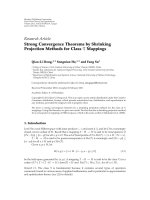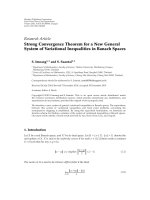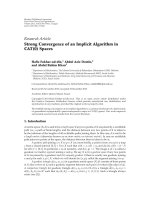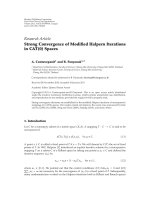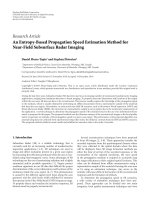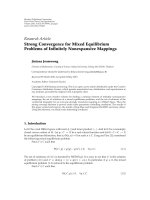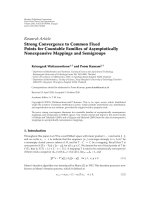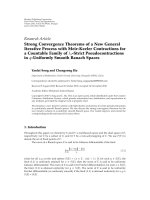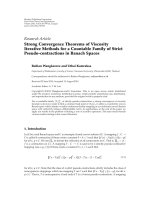Báo cáo hóa học: " Research Article Strong Convergence Theorems of the CQ Method for Nonexpansive Semigroups Huimin He and Rudong Chen" pptx
Bạn đang xem bản rút gọn của tài liệu. Xem và tải ngay bản đầy đủ của tài liệu tại đây (490.62 KB, 8 trang )
Hindawi Publishing Corporation
Fixed Point Theory and Applications
Volume 2007, Article ID 59735, 8 pages
doi:10.1155/2007/59735
Research Article
Strong Convergence Theorems of the CQ Method for
Nonexpansive Semigroups
Huimin He and Rudong Chen
Received 25 January 2007; Accepted 19 March 2007
Recommended by Jerzy Jezierski
Motivated by T. Suzuki, we show strong convergence theorems of the CQ method for
nonexpansive semigroups in Hilbert spaces by hybrid method in the mathematical
programming. The results presented extend and improve the corresponding results of
Kazuhide Nakajo and Wataru Takahashi (2003).
Copyright © 2007 H. He and R. Chen. This is an open access article distributed under
the Creative Commons Attribution License, which permits unrestricted use, distribution,
and reproduction in any medium, provided the original work is properly cited.
1. Introduction and preliminaries
Throughout this paper, let H be a real Hilbert space with inner product
·,· and ·.We
use x
n
x to indicate that the sequence {x
n
} converges weakly to x. Similarly, x
n
→ x will
symbolize strong convergence. we denote by
N and R
+
the sets of nonnegative integers
and nonnegative real numbers, respectively. let C be a closed convex subset of a Hilbert
space H,andLetT : C
→ C be a nonexpansive mapping (i.e., Tx − Ty≤x − y for
all x, y
∈ C). We use Fix(T) to denote the set of fixed points of T; that is, Fix(T) ={x ∈
C : x = Tx}. We know that Fix(T)isnonemptyifC is bounded, for more details see [1].
In [2], Shioji and Takahashi introduce in a Hilbert space the implicit iteration
x
n
= α
n
u +
1 − α
n
1
t
n
t
n
0
T(s)x
n
ds, n ∈ N, (1.1)
Where
{α
n
} is a sequence in (0,1), {t
n
} is a sequence of positive real numbers divergent to
∞,foreacht ≥ 0andu ∈ C. In 2003, Suzuki [3] is the first to introduce again in a Hilbert
space the following implicit iteration process:
x
n
= α
n
u +
1 − α
n
T
t
n
x
n
, n ≥ 1, (1.2)
2 Fixed Point Theory and Applications
for the nonexpansive semigroup case. In 2005, Xu [4] established a Banach space version
of the sequence (1.2) of Suzuki [3], he proved that if E is a uniformly convex Banach space
with a weakly continuous dualit y map (e.g., l
p
for 1 <p<∞), if C isaclosedconvexsub-
set of E,andif
{T(t):t ∈ R
+
} is a nonexpansive semigroup on a closed convex subset
C such that Fix(T)
=∅, then under certain appropriate assumptions made and the se-
quences α
n
and t
n
of the parameters, he showed that the sequence x
n
implicitly defined
by (1.2)foralln
≥ 1 converges strongly to a member of F =
t≥0
Fix(T(t)).
Recently, Chen and He [5] extend and improve the corresponding results of Suzuki
[3], if E is a reflexive Banach space which admits a weakly sequentially continuous duality
mapping J from E to E
∗
,supposeC is a nonempty closed convex subset of E.Let{T(t):
t
∈ R
+
} be a nonexpansive semigroup on C such that F(T) =∅,and f : C → C is a fixed
contraction on C.Let
{α
n
} and {t
n
} be sequences of real numbers satisfying 0 <α
n
< 1,
t
n
> 0andlim
n→∞
t
n
= lim
n→∞
α
n
/t
n
= 0. Define a sequence {x
n
} in C by
x
n
= α
n
f
x
n
+
1 − α
n
T
t
n
x
n
, n ≥ 1. (1.3)
Then
{x
n
} conv erges strongly to q,asn →∞. q is the element of F,suchthatq is the
unique solution in F to the following variational inequality:
( f − I)q, j(x − q)
≤
0 ∀x ∈ F(T). (1.4)
Some other results can be seen in [6 –8].
Nakajo and Takahashi [9] introduced an iteration procedure for nonexpansive self-
mappings T on C as follows:
x
0
= x ∈ C,
y
n
= α
n
x
n
+
1 − α
n
Tx
n
,
C
n
=
z ∈ C;
y
n
− z
≤
x
n
− z
,
Q
n
=
z ∈ C;
x
n
− z,x
0
− x
n
≥
0
,
x
n+1
= P
C
n
∩Q
n
x
0
(1.5)
for each n
∈ N ∪{0},whereα
n
∈ [0,a]forsomea ∈ [0,1), and {x
n
} converges strongly
to P
Fix(T)
x
0
Let {T(t):t ∈ R
+
} be a nonexpansive semigroup on a closed convex subset C of a
Hilbert space H, that is,
(1) for each t
∈ R
+
, T(t) is a nonexpansive mapping on C;
(2) T(0)x
= x for all x ∈ C;
(3) T(s + t)
= T(s) ◦ T(t)foralls,t ∈ R
+
;
(4) for each x
∈ X, the mapping T(·)x from R
+
into C is continuous. We put F =
t≥0
Fix(T(t)). We know that F is nonempty if C is bounded, see [10].
Let C be a nonempty closed convex subset of H and let
{T(t):t ∈ R
+
} be a nonex-
pansive semigroup on a closed convex subset C of a Hilbert space H such that F
=∅,
H. He and R. Chen 3
Nakajo and Takahashi [9] also introduced an iteration procedure for nonexpansive semi-
group
{T(t):t ∈ R
+
} on C as follows:
x
0
= x ∈ C,
y
n
= α
n
x
n
+
1 − α
n
1
t
n
t
n
0
T(s)x
n
ds,
C
n
=
z ∈ C;
y
n
− z
≤
x
n
− z
,
Q
n
=
z ∈ C;
x
n
− z,x
0
− x
n
≥
0
,
x
n+1
= P
C
n
∩Q
n
x
0
(1.6)
for each n
∈ N ∪{0},whereα
n
∈ [0,a]forsomea ∈ [0,1) and {t
n
} is a positive real
number divergent sequence, and the sequence
{x
n
} converges strongly to P
F
x
0
.
In 2006, Martinez-Yanes and Xu [11] employ Nakajo-Takahashi [9] idea and prove
some strong convergence theorems for nonexpansive mappings and maximal monotone
operators.
In this paper, we consider an iteration procedure for nonexpansive semigroups
{T(t):
t
∈ R
+
} on C as follows:
x
0
= x ∈ C,
y
n
= α
n
x
n
+
1 − α
n
T
t
n
x
n
,
C
n
=
z ∈ C;
y
n
− z
≤
x
n
− z
,
Q
n
=
z ∈ C;
x
n
− z,x
0
− x
n
≥
0
,
x
n+1
= P
C
n
∩Q
n
x
0
(1.7)
for each n
∈ N ∪{0},whereα
n
∈ [0,a]forsomea ∈ [0,1) and t
n
≥ 0lim
n→∞
t
n
= 0. then
the sequence
{x
n
} converges strongly to P
F
x
0
.
In the sequel, we will need the following definitions and results.
Definit ion 1.1. ABanachspaceE is said to satisfy Opial’s condition [12]ifwhenever
{x
n
}
is a sequence in E which converges weakly to x,asn →∞,then
limsup
n→∞
x
n
− x
< limsup
n→∞
x
n
− y
, ∀y ∈ E with x = y. (1.8)
It is well known that Hilbert space and l
p
(1 <l<∞) space satisfy Opial’s condition
[13].
Lemma 1.2 [14]. Let C beanonemptyclosedconvexsubsetofaHilbertspaceH.Given
x
∈ H and y ∈ C, then y = P
C
x if and only if x − y, y − z≥0, is satisfied for all z ∈ C.
Lemma 1.3 [14, 15]. Ever y Hilbert space H has Radon-Riesz property or Kadets-Klee prop-
erty, that is, for a sequence
{x
n
}⊂H with x
n
x and x
n
→x, then there holds x
n
→ x.
4 Fixed Point Theory and Applications
2. Main results
Lemma 2.1. Let C beaclosedconvexsubsetofaHilbertspaceH.Let
{T(t):t ∈ R
+
} be a
nonexpansive s emigroup on C such that F
=∅, and the sequence {x
n
} generated by (1.7),
where α
n
∈ [0, a] for some a ∈ [0,1), Then {x
n
} is well defined and F ⊂ C
n
∩ Q
n
for every
n
∈ N ∪{0}.
Proof. It is obvious that C
n
is closed and Q
n
is closed and convex for every n ∈ N ∪{0}.
It follows from that C
n
is convex for every n ∈ N ∪{0} because y
n
− z≤x
n
− z is
equivalent to
y
n
− x
n
2
+2
y
n
− x
n
,x
n
− z
≤
0. (2.1)
So, C
n
∩ Q
n
is closed and convex for every n ∈ N ∪{0}.Letu ∈ F.Thenfrom
y
n
− u
=
α
n
x
n
+
1 − α
n
T
t
n
x
n
− u
≤ α
n
x
n
− u
+
1 − α
n
T
t
n
x
n
− u
≤
x
n
− u
.
(2.2)
we have u
∈ C
n
for each n ∈ N ∪{0}.So,wehaveF ⊂ C
n
for all n ∈ N ∪{0}.
Next, we show by mathematical induction that
{x
n
} is well defined and F ⊂ C
n
∩ Q
n
for every n ∈ N ∪{0}.Forn = 0, we have x
0
= x ∈ C and Q
0
= C, and hence F ⊂ C
0
∩ Q
0
.
Suppose that x
k
is given and F ⊂ C
k
∩ Q
k
for some k ∈ N ∪{0}.There exists a unique
element x
k+1
∈ C
k
∩ Q
k
such that x
k+1
= P
C
k
∩Q
k
(x
0
). From x
k+1
= P
C
k
∩Q
k
(x
0
), it holds
that
x
k+1
− z,x
0
− x
k+1
≥
0 (2.3)
for each z
∈ C
k
∩ Q
k
.SinceF ⊂ C
k
∩ Q
k
,wegetF ⊂ Q
k+1
, therefore we have F ⊂ C
k+1
∩
Q
k+1
.
The proof is completed.
Lemma 2.2. Let C beaclosedconvexsubsetofaHilbertspaceH.Let{T(t):t ∈ R
+
} be a
nonexpansive s emigroup on C such that F
=∅, and the sequence {x
n
} generated by (1.7),
where α
n
∈ [0,a] for some a ∈ [0, 1), The n lim
n→∞
x
n+1
− x
n
=0.
Proof. At first, we show that F is a closed convex subset of C.SinceT(t):C
→ C, t>0is
nonexpansive, we claim that F is closed. In fact, if p
n
⊂ F =
t≥0
Fix(T(t)), n ≥ 1, such
that lim
n→∞
p
n
= p,thenwehave
T(t)p
= lim
n→∞
T(t)p
n
= lim
n→∞
p
n
= p ∀t ∈ R
+
. (2.4)
Thus p
∈ F.
Next, we show that F is convex, we will use the following identity in Hilbert space:
tx +(1− t)y
2
= tx
2
+(1− t)y
2
− t(1 − t)x − y
2
, (2.5)
H. He and R. Chen 5
which holds for all x, y
∈ H and for all t ∈ [0,1] indeed,
tx +(1− t)y
2
= t
2
x
2
+(1− t)
2
y
2
+2t(1 − t)x, y
=
tx
2
+(1− t)y
2
+2t(1 − t)x, y
−
t(1 − t)x
2
− t(1 − t)y
2
= tx
2
+(1− t)y
2
− t(1 − t)
x
2
+ y
2
− 2x, y
=
tx
2
+(1− t)y
2
− t(1 − t)x − y
2
.
(2.6)
Let p
1
, p
2
∈ F and for all t ∈ [0,1], p = tp
1
+(1− t)p
2
,then
p
− p
1
= (1 − t)
p
2
− p
1
, p − p
2
= (1 − t)
p
1
− p
2
. (2.7)
From (2.5)and(2.7), we have
p − T(t)p
2
=
t
p
1
− T(t)p
+(1− t)
p
2
− T(t)p
2
= t
p
1
− T(t)p
2
+(1− t)
p
2
− T(t)p
2
− t(1 − t)
p
1
− p
2
2
≤ t
p
1
− p
2
+(1− t)
p
2
− p
2
− t(1 − t)
p
1
− p
2
2
= t(1 − t)
2
p
1
− p
2
2
+ t
2
(1 − t)
p
1
− p
2
2
− t(1 − t)
p
1
− p
2
2
= t(1 − t)(1 − t + t − 1)
p
1
− p
2
2
= 0.
(2.8)
Thus p
= T(t)p,forallt>0, that is, p ∈ F.
Secondly, we show that
{x
n
} is bounded. Since F is a nonempty closed convex subset
of C, there exists a unique element z
0
∈ F such that z
0
= P
F
(x
0
). From x
n+1
= P
C
n
∩Q
n
(x
0
),
we have
x
n+1
− x
0
≤
z − x
0
∀
z ∈ C
n
∩ Q
n
. (2.9)
It follows from Lemma 2.1 that F
⊂ C
n
∩ Q
n
for every n ∈ N ∪{0}, together with z
0
∈
F(T), we have
x
n+1
− x
0
≤
z
0
− x
0
∀
n ∈ N ∪{0}. (2.10)
This implies that
{x
n
} is bounded, so {T(t)x
n
} is also bounded, and moreover so is
{y
n
} since y
n
≤α
n
x
n
+(1− α
n
)T(t)x
n
.
Thirdly, we show that
x
n+1
− x
n
→0asn →∞.SinceQ
n
={z ∈ C; x
n
− z,x
0
− x
n
≥
0}, x
n
= P
Q
n
(x
0
). As x
n+1
∈ C
n
∩ Q
n
⊂ Q
n
,weobtain
x
n+1
− x
0
≥
x
n
− x
0
, ∀z ∈ C
n
∩ Q
n
. (2.11)
6 Fixed Point Theory and Applications
Therefore the sequence
{x
n
− x
0
} is bounded and nondecreasing. So
lim
n→∞
x
n
− x
0
exists. (2.12)
On the other hand, from x
n+1
∈ Q
n
,wegetx
n
− x
n+1
,x
0
− x
n
≥0, and hence
x
n
− x
n+1
2
=
x
n
− x
0
−
x
n+1
− x
0
2
=
x
n
− x
0
2
− 2
x
n
− x
0
,x
n+1
− x
0
+
x
n+1
− x
0
2
=
x
n
− x
0
2
+
x
n+1
− x
0
2
− 2
x
n
− x
0
,x
n+1
− x
n
+ x
n
− x
0
=
x
n+1
− x
0
2
−
x
n
− x
0
2
− 2
x
n
− x
n+1
,x
0
− x
n
≤
x
n+1
− x
0
2
−
x
n
− x
0
2
−→ 0(n −→ ∞ ).
(2.13)
So
lim
n→∞
x
n+1
− x
n
=
0. (2.14)
This proof is completed.
Theorem 2.3. Let C be a closed convex subset of a Hilbert space H.Let{T(t):t ∈ R
+
}
be a nonexpansive semigroup on C such that F =∅, and the sequence {x
n
} generated by
(1.7), where α
n
∈ [0, a] for some a ∈ [0,1),andt
n
≥ 0lim
n→∞
t
n
= 0. then the sequence
{x
n
} converges strongly to P
F
x
0
.
Proof. It follows from x
n+1
∈ C
n
that
T
t
n
x
n
− x
n
=
1
1 − α
n
y
n
− x
n
≤
1
1 − α
n
y
n
− x
n+1
+
x
n+1
− x
n
≤
2
1 − α
n
x
n+1
− x
n
(2.15)
for every n
∈ N ∪{0}.ByLemma 2.2,wegetT(t
n
)x
n
− x
n
→0.
We claim that
{x
n
} is relatively sequentially compact. Indeed, there exists a weakly
convergence subsequence
{x
n
j
}⊆{x
n
} by reflexivity of H and boundedness of the se-
quence
{x
n
},nowwesupposex
n
j
x ∈ C( j →∞). Now we show that x ∈ F.Putx
j
= x
n
j
,
β
j
= α
n
j
,ands
j
= t
n
j
for j ∈ N,lets
j
≥ 0besuchthat
s
j
−→ 0,
T
s
j
x
j
− x
j
s
j
−→ 0, j −→ ∞ . (2.16)
H. He and R. Chen 7
Fix t>0, from
x
j
− T(t)x
≤
[t/s
j
]−1
k=0
T
(k +1)s
j
x
j
− T
ks
j
x
j
+
T
t
s
j
s
j
x
j
− T
t
s
j
s
j
x
+
T
t/s
j
s
j
x − T(t)x
≤
t
s
j
T
s
j
x
j
− x
j
+
x
j
− x
+
T
t −
t
s
j
s
j
x − x
≤
t
T
s
j
x
j
− x
j
s
j
+
x
j
− x
+max
T(s)x − x
:0≤ s ≤ s
j
.
(2.17)
For all j
∈ N ∪{0}, as every Hilbert space satisfies Opial’s condition, then we have
limsup
j→∞
x
j
− T(t)x
≤
limsup
j→∞
x
j
− x
.
(2.18)
This implies that T(t)x
= x. Therefore,
x
∈ F. (2.19)
If z
0
= P
F
(x
0
), it follows from (2.10), (2.19), and the lower semicontinuity of the norm
that
x
0
− z
0
≤
x
0
− x
≤
liminf
j→∞
x
0
− x
n
j
≤
limsup
j→∞
x
0
− x
n
j
≤
x
0
− z
0
. (2.20)
Thus, we obtain
lim
j→∞
x
n
j
− x
0
=
x
0
− x
=
x
0
− z
0
. (2.21)
This implies that
x
n
j
−→ x = z
0
. (2.22)
This shows that
{x
n
} is relatively sequentially compact. Therefore, we have x
n
→ z
0
.
The proof is completed.
Acknowledgment
This work is partially supported by the National Science Foundation of China, Grant
10471033.
8 Fixed Point Theory and Applications
References
[1] F. E. Browder, “Fixed-point theorems for noncompact mappings in Hilbert space,” Proceedings
of the National Academy of Sciences of the United States of America, vol. 53, no. 6, pp. 1272–1276,
1965.
[2] N. Shioji and W. Takahashi, “Strong convergence theorems for asymptotically nonexpansive
semigroups in Hilbert spaces,” Nonlinear Analysis, vol. 34, no. 1, pp. 87–99, 1998.
[3] T. Suzuki, “On strong convergence to common fixed points of nonexpansive semigroups in
Hilbert spaces,” Proceedings of the American Mathematical Society, vol. 131, no. 7, pp. 2133–2136,
2003.
[4] H K. Xu, “A strong convergence theorem for contraction semigroups in Banach spaces,” Bulletin
of the Australian Mathematical Society, vol. 72, no. 3, pp. 371–379, 2005.
[5] R. Chen and H. He, “Viscosity approximation of common fixed points of nonexpansive semi-
groups in Banach space,” to appear in Applied Mathematics Letters.
[6] R. Chen and Z. Zhu, “Viscosity approximation fixed points for nonexpansive and m-accretive
operators,” Fixed Point Theory and Applications, vol. 2006, Article ID 81325, 10 pages, 2006.
[7] R. Chen, Y. Song, and H. Zhou, “Convergence theorems for implicit iteration process for a fi-
nite family of continuous pseudocontractive mappings,” Journal of Mathematical Analysis and
Applications, vol. 314, no. 2, pp. 701–709, 2006.
[8] Y. Yao and R. Chen, “Iterative algorithm for approximating solutions of maximal monotone
operators in Hilbert spaces,” Fixed Point Theory and Applications, vol. 2007, Article ID 32870, 8
pages, 2007.
[9] K. Nakajo and W. Takahashi, “Strong convergence theorems for nonexpansive mappings and
nonexpansive semigroups,” Journal of Mathematical Analysis and Applications, vol. 279, no. 2,
pp. 372–379, 2003.
[10] F. E. Browder, “Nonexpansive nonlinear operators in a Banach space,” Proceedings of the National
Academy of Sciences of the United States of America, vol. 54, no. 4, pp. 1041–1044, 1965.
[11] C. Martinez-Yanes and H K. Xu, “Strong convergence of the CQ method for fixed point itera-
tion processes,” Nonlinear Analysis, vol. 64, no. 11, pp. 2400–2411, 2006.
[12] Z. Opial, “Weak convergence of the sequence of successive approximations for nonexpansive
mappings,” Bulletin of the American Mathematical Society, vol. 73, pp. 591–597, 1967.
[13] K. Yanagi, “On some fixed point theorems for multivalued mappings,” Pacific Journal of Mathe-
matics, vol. 87, no. 1, pp. 233–240, 1980.
[14] R. E. Megginson, An Introduction to Banach Space Theory, vol. 183 of Graduate Texts in Mathe-
matics, Springer, New York, NY, USA, 1998.
[15] W. Takahashi, Nonlinear Functional Analysis. Fixed Point Theory and Its Applications, Yokohama
Publishers, Yokohama, Japan, 2000.
Huimin He: Department of Mathematics, Tianjin Polytechnic University, Tianjin 300160, China
Email address:
Rudong Chen: Department of Mathematics, Tianjin Polytechnic University, Tianjin 300160, China
Email address:

